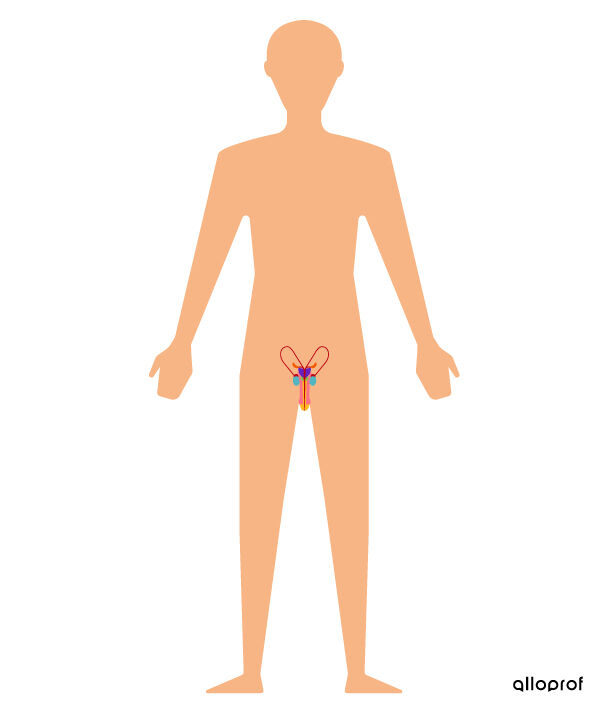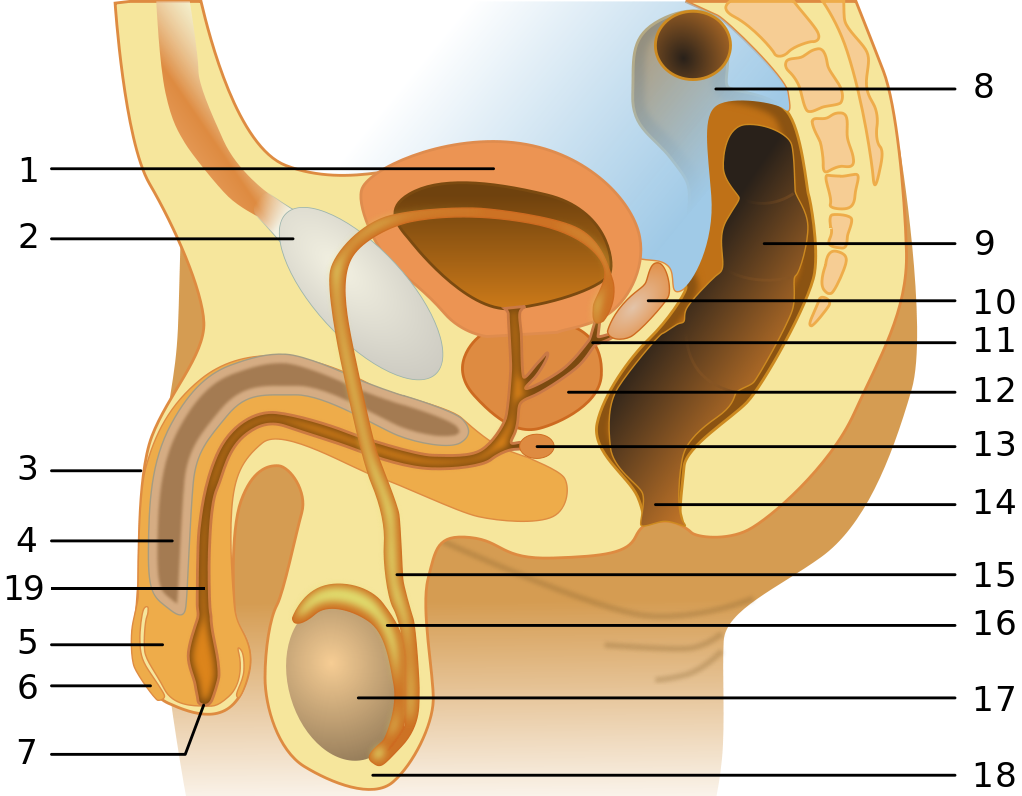The male reproductive system includes all the organ structures in male reproduction. It includes the reproductive organs, as well as their associated hormonal glands.
The male reproductive system has two functions. First, it allows new individuals to be formed with a genetic makeup derived from the blending of the parents’ genes. Secondly, this system helps to maintain physiological balance in male bodies by playing a very important role in the last phase of growth: puberty.

Hormonal glands produce and secrete hormones. Hormones are chemical substances that, after being secreted by a gland and entering the bloodstream, transmit messages throughout the body. Each hormone has a different chemical structure, which means that they carry different messages. Often, they contain very specific instructions intended for specialized cells.
The anatomy of the male reproductive system includes:
**Internal organs
**External organs
**Organs not included in the reproductive system
-
Bladder
-
Pubis
-
Penis
-
Corpus cavernosum
-
Glans penis
-
Prepuce
-
Urinary meatus
-
Sigmoid colon
-
Rectum
-
Seminal vesicle
-
Seminal duct
-
Prostate
-
Cowper’s gland
-
Anus
-
Vas deferens
-
Epididymis
-
Testicle
-
Scrotum
-
Urethra
The external part of the male reproductive system has two main structures: the scrotum, which contains the testicles, and the penis, the male reproductive organ.
The scrotum is a sac that contains the testicles located at the base of the penis and hanging below the abdominal pelvic cavity. It is separated in the middle to form two halves, each containing a testicle.
Spermatogenesis is the production of spermatozoa that occurs in the testicles. This process cannot occur at the internal body temperature (36.2˚C). It requires a temperature that is 3˚C lower than that of the body. The scrotum has muscles that allow it to contract and expand. By doing this, the scrotum can move the testicles closer to or further away from the body to prevent or maximize heat loss.
The penis is an organ that allows the sexual reproduction of humans by releasing semen into the female reproductive system. The glans penis is the bell-shaped tip of the penis. The urinary meatus is an opening at the end of the glans penis through which semen and urine are evacuated. This structure is not part of the male reproductive system. The prepuce is the skin that covers the glans penis. Removing the prepuce is called circumcision and can be performed for medical reasons (e.g., repeated infections), for hygienic reasons or for religious reasons.
The internal part of the human reproductive system contains the majority of its structures including the testicles, where spermatozoa are produced, a network of ducts where the spermatozoa circulate, as well as some accessory glands.
The testicles have two functions: to produce spermatozoa (spermatogenesis) and to produce hormones (e.g., testosterone). They are about 4 cm long and have a diameter of about 2.5 cm.
Each testicle contains between 250 and 300 compartments called lobules. Each of them has between 1 and 4 convoluted seminiferous tubules, which is the precise location of spermatozoa production. These are then directed through the straight tubules and on to the rete testis. This network of ducts constitutes the exit door for spermatozoa from the testicle to the epididymis.
When the spermatozoa leave the seminiferous tubules, they first travel through the epididymis. This duct is attached to the testicle and is the main reservoir of living spermatozoa. Then, the spermatozoa go through the vas deferens whose end is enlarged and called the ampulla of vas deferens. The seminal fluid from the seminal vesicle and the spermatozoa from the ampulla of vas deferens mix, creating semen, and flow into the ejaculatory duct. This duct meets the urethra by the prostate and the semen is expelled via the urinary meatus.
The spermatozoa path (from spermatogenesis to ejaculation)
Seminal vesicles
There are two seminal vesicles attached to the bladder on the posterior wall. They are between 5 and 7 cm long. They produce a liquid that makes up most of the volume of the semen. The duct of each seminal vesicle joins the vas deferens. Where they meet is called the ejaculatory duct.
The seminal fluid is alkaline in nature and is yellowish in colour. It contains fructose, ascorbic acid, coagulation proteins and prostaglandins. It makes up about 50% of semen.
Prostate
Unlike the seminal vesicles, there is only one prostate. It is about the size of a ping-pong ball and shaped like a donut. It surrounds the seminal duct and the part of the urethra located under the bladder. During ejaculation, the fluid produced by the prostate joins the semen at the prostatic part of the urethra. This liquid nourishes and activates the spermatozoa.
The prostatic fluid is milky, slightly acidic and contains enzymes and nutrients for the spermatozoa. It makes up about 35% of semen.
Cowper’s glands
Also called bulbourethral glands, Cowper’s glands are the size of a pea and are located under the prostate. The fluid they produce lubricates the tip of the penis during sexual intercourse.
The pre-ejaculatory fluid, produced by the Cowper’s glands, also neutralizes the acidic traces of urine that may remain in the urethra and lubricates it for the flow of semen. This liquid is translucent and flows out before ejaculation. It makes up about 5% of semen.
